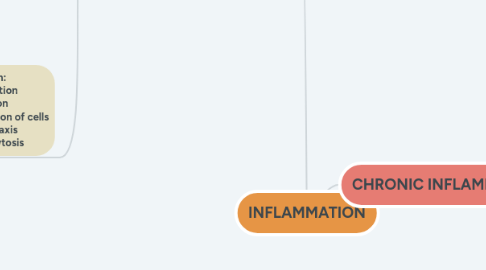
1. ACUTE INFLAMMATION
1.1. Duration: minutes to days
1.2. Characterized by: hyperemia & exudation
1.3. Polymorphonuclear leukocytes: neutrophils (basophils and eosinophils)
1.4. Vascular changes
1.4.1. Changes in vascular flow and caliber
1.4.1.1. Transient vasoconstriction following by vasodilation of arterioles
1.4.1.2. Increased blood flow causes erythema
1.4.1.3. Exudation of protein-rich fluid into extravascular spaces
1.4.1.4. Blood viscosity increases, small BV packed with RBC (stasis)
1.4.1.5. Margination and emigration of leukocytes
1.4.2. Increased vascular permeability (vascular leakage)
1.5. Mechanism: 1. Vasodilation 2. Exudation 3. Emigration of cells 4. Chemotaxis 5. Phagocytosis
1.5.1. Leucocyte cellular events
1.5.1.1. Margination and rolling
1.5.1.1.1. Accumulation of WBC on periphery and binding with endothelial surface
1.5.1.1.2. Mediated by the binding of complementary adhesion molecules on WBC and endothelial surface
1.5.1.2. Adhesion and transmigration
1.5.1.2.1. WBC adhere to endothelial surface
1.5.1.2.2. WBC undergo diapedesis through the basement membrane into extravascular space
1.5.1.2.3. Mediated by endothelial adhesion molecules of Ig super family
1.5.1.3. Chemotaxis
1.5.1.3.1. WBC migrate toward injury along chemical gradient
1.5.1.3.2. Chemotactic agents: soluble bacterial products, complement system, products of arachidonic acid pathway metabolism, cytokines
1.5.1.3.3. Bind to specific receptors on WBC and stimulate cell movement & activation
1.5.1.4. Phagocytosis
1.5.1.4.1. Recognition and attachment of particle to ingesting WBC
1.5.1.4.2. Engulfment and formation of phagocytic vacuole
1.5.1.4.3. Killing and degradation of ingested material
